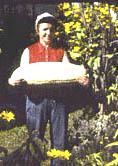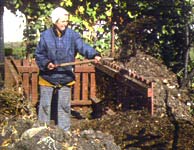Biogardener Homepage
with links to my other websites
Getting Started Organically
start with the basics
Environmental Issues
the law & the practice
Edible Garden
for food, drink & medicine
Trees & Shrubs
Mother Nature's way
Traute Klein, biogardener
Webmaster's background & work

 Send me your own organic gardening story. Email me by clicking on the mailbox graphic. Send me your own organic gardening story. Email me by clicking on the mailbox graphic.
Related Articles
Disaster-proofing Your Soil
To withstand floods as well as droughts, soil needs to be water-retentive. The most important ingredient of my soil is leaves, and in my community, it is the easiest to obtain free of charge.
Leaves of Gold
Leaves are the secret to a successful garden. They not only make soil water-retentive, they add back to it the micronutrients which were leached from the topsoil by rain and unnecessary watering.
Paradise Lost, the Tyranny of Conformity
Carol Wallace's account of the illegal destruction of my naturalized garden by the bureaucracy in 1998.

Rodale Organic Gardening
Book at Amazonby Organic Gardening Magazine
More Environmental Gardening
Books at Amazon

|
Disaster-proofing Your Garden
by Traute Klein, biogardener
To develop a garden which will withstand natural disasters, choose plants which thrive in the local environment, improve the soil, and practice companion planting.
A Plant for Every EnvironmentAre you tired of fighting Nature? Are you ready to plan the kind of garden which will survive without coddling, without irrigation, without daily attention? I was ready for that after my first year of gardening. Fussing is not for me. If a plant does not do well in the local environment, if it does not like my soil, if it does not like my climate, then I have no use for it. There are enough plants around which will thrive here, and the Morden Experimental Farm is still developing strains of plants which love our extreme prairie conditions.
Certainly, there are a few plants to which I am emotionally attached since my childhood, and I pine for them every spring, when all my favorites are in bloom in Germany, but I make no attempt at growing them here. They were not meant to thrive in the extremes of continental climate, and I am content with painting them.
Taking Stock
Have a look around your garden to see which plants are thriving, which ones are surviving without too much help from you, and which ones are barely alive. Better still, go into the countryside and observe which plants seem to own the land. They may not even be native to the area. They may have been imported by early settlers or later immigrants. I myself have introduced some plants from Europe which are doing well in gardens all over Winnipeg. I also brought plants here which have died a quiet death in spite of special care. As much as I loved them, I shall not give them a second chance.
Anticipate Disasters
History normally repeats itself. We should therefore anticipate disasters and make long-range preparations. I do not consider cold winters as disasters in the Canadian prairies in which I live. I consider them to be annual events. A mild winter, however, is a calamity for us, because we are not prepared for winter thaws. It kill our perennials and spring bulbs.
I do not even consider a July drought a natural disaster. I expect it. If it is preceded by a spring flood or at least heavy precipitation, I am able to save much of the excess water until July. Better still, I prepare my garden to survive several weeks of the annual drought, even without watering. That way, I am not a slave to my garden, but am able to spend time painting. I even take short vacations in the summer without having to worry about finding a dead garden on my return. Read my article, "Prepare Your Soil for Drought of Flood," linked in the left column, to find out how you can do it as well. And no, my husband is not a gardener. He would not notice if a plant is thirsty or dead.
What then are the disasters for which I prepare?
- Flooding
My entire garden is laid out in raised beds of compost. The rich soil is able to retain water without drowning the plants. I avoid plants with light-green or variegated leaves. They do not withstand even short periods of flooding as their chloropyl-rich cousins do.
- An extended drought
The most important preparation is complete mulching. Soil does not have to be visible to be useful. I cover all of it with grass clippings in the summer and with dried leaves from autumn to spring.
- Insect invasions
Insects thrive on monocultures. Companion planting prevents pest invasions. While teaching in southern Alberta, I observed an army of grasshoppers laying down an entire grain field in one sweep. I also see the grasshoppers in my 20 acre hayfield die of malnutrition. They are almost transparent. They are programmed to feed on one single crop at a time. Not being able to find it, they get confused and starve.
- Storms
Unless a twister cuts a wide swath, some of your garden might be saved if it is scattered over as wide an area as possible. I am planting my fruit trees in various areas of my 20 acre field.
- Insect pests and diseases
I practice the principle of companion planting to the extent where I avoid planting two trees of the same plant family in proximity of each other. This prevents insects and diseases from wiping out all related plants at the same time. I also surround plants with protective herbs. Perennial onions, for example, protect plants from aphids, rabbits, and black spot. A ring of fresh manure appears to protect trees from rodent attacks. I am still experimenting with this one, and have found that the rodents march right over the frozen manure in the winter.
Conclusion
You may not be able to avert disaster. You may not even be able prepare for it fully. You will, however, be able to minimize its effects by careful planning. Get ready for the next natural disaster by careful selection of plants and by deliberate planning of your garden.
© Traute Klein, biogardener
|

